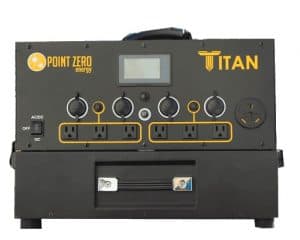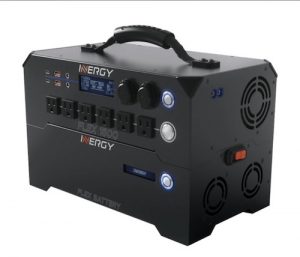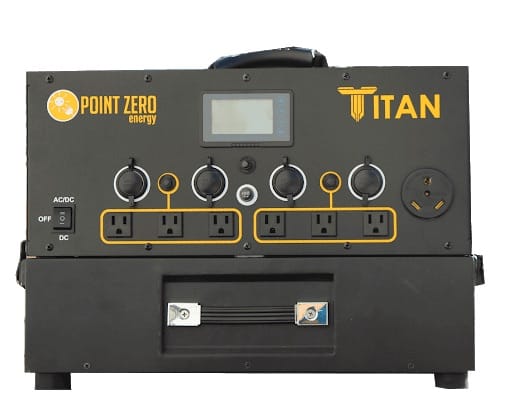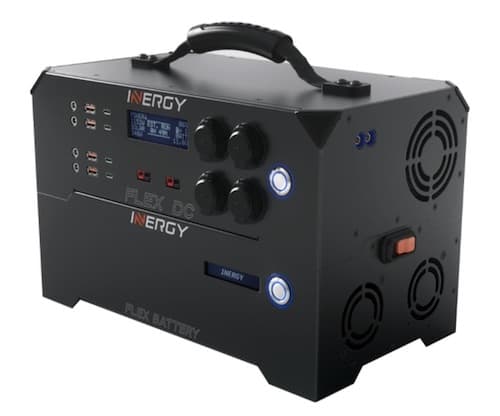As Goal Zero continues to make improvements to their line of solar generators, they continue to have a leg up on their previous models.
The Goal Zero Yeti 3000X is one such example.
The Yeti 3000X is one of several “X” models by Goal Zero. This solar generator line is the successor of the “Lithium” series generators. The 3000X has 3,032Wh of battery capacity and an inverter that supports 2,000W of continuous power output and 3,500W of surge power.
Since there are several models in the “X” line, we will be focusing on the Yeti 3000X specifically.
Some other models include the 1000X, 1500X, 200X, 500X, 3000X, and 6000X. That’s a lot of power!
Let’s get right into it.
Yeti 3000X – What Makes It Stand Out?
Similar to the 1500X, the 3000X has a more powerful inverter along with an MPPT charge controller. The previous generation of large Yeti Lithium models had a 1,500W continuous output with a 3,000W surge capability.
This amount of power is usually sustainable enough for most users, but Goal Zero has enhanced the inverter capabilities to 2,000W continuous and 3,500W surge for the 1500X, 3000X, and 6000X models.
With that being said, the MPPT charge controller is a huge improvement over the previous Yeti models because they came with a PWM charge controller.
MPPT controllers tend to be more efficient than PWMs at transferring energy to the battery.
This is because MPPTs can capture excess voltage from solar panels when a PWM can only charge at the same rate as the battery’s voltage.
In total, the Yeti 3000X (amazon link) has the ability to take in up to 600W of solar input to charge up.
Below you’ll find the full specifications of both the 3000X and its predecessor, the 3000 Lithium, to see exactly what changes were made in the newer model.
Specs Overview – Yeti 3000X vs Yeti 3000 Lithium
| Model | Yeti 3000X | Yeti 3000 Lithium |
|---|---|---|
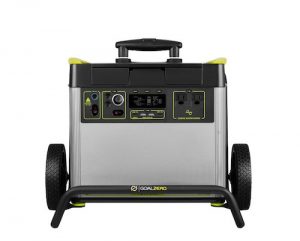 | 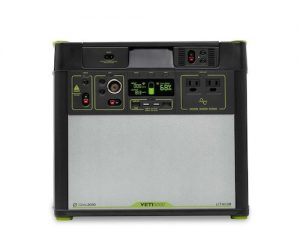 | |
| Battery Type | Lithium-ion NMC | Lithium-ion NMC |
| Battery Cycle Life | 500 cycles to 80% capacity | 500 cycles to 80% capacity |
| Battery Capacity | 3,032Wh (10.8V, 280.8Ah) | 3,075Wh (10.95V, 280.8Ah) |
| Weight (w/ Roll Cart) | 79 lbs (power station: 69.78 lbs; roll cart: 8.9 lbs) | 78 lbs (power station: 68.6 lbs; roll cart: 8.9 lbs) |
| Dimensions (Yeti Only) | 15.25 x 10.23 x 13.6 in | 10.1 x 15.3 x 13.1 in |
| Dimensions (Yeti w/ Roll Cart) | 20.5 x 14.6 x 18.2 in | Not found in manual |
| Charge Controller | MPPT | PWM & MPPT |
| AC Outputs | 2x Outputs (2,000W continuous, 3,500W surge) | 2x Outputs (1,500W continuous, 3,000W surge) |
| USB Outputs | 2x USB-A (12W max; regulated) 1x USB-C (18W max; regulated) 1x USB-C PD (60W max; regulated) | 2x USB-A (12W max; regulated) 1x USB-C (15W max; regulated) 1x USB-C PD (60W max; regulated) |
| 12V Outputs | 1x High Power Port (up to 30A, 360W max; regulated) 1x Car port (up to 13A, 160W max; regulated) 2x 6mm ports (up to 10A, 120W max; regulated) | 1x High Power Port (up to 20A, 240W max) 1x Car port (up to 10A, 120W max) 2x 6mm ports (up to 10A, 120W max) |
| Inputs | 1x High Power charging port: 14-50V, up to 50A (600W max) 2x 8mm ports: 14-50V, up to 10A (150W max) 1x USB-C PD (60W max) | 1x High Power charging port: 14-22V, up to 30A (360W max) 1x 8mm port: 14-22V, up to 10A (120W max) MPPT Module inputs (pre-installed): 1x High Power charging port: 15-22V, up to 25A (325W max) 2x 8mm ports: 15-22V, up to 10A (150W max per port) |
| Charging Times | Solar charging @ max input (600W): 6 hrs AC charging w/ included 230W charger: 14 hrs AC charging w/ optional 600W charger: 6 hrs | Solar charging @ max input (around 955W): 3.2 hrs AC Charging w/ 2x 5A chargers (included): 25 hrs |
| References | Yeti 3000X manual | Yeti 3000 Lithium manual |
For more information regarding the Yeti 3000 models, I dive deeper into their differences in my comparison post found here: Goal Zero Yeti 3000X vs Yeti 3000 Lithium (Ports, Features, & More).
Who Is the Yeti 3000X For?
The 3000X is a massive solar generator. It is heavy and bulky for certain events. But if you’re using it for the following events, it will be a very useful tool on deck.
Using the Yeti 3000X at a Tailgating Event
Going to a sporting event parking lot or a family event outside is a perfect way to use the 3000X.
It has enough power to run electric stoves, speakers, TVs, and more with its various ports and extensive battery size.
RV Camping
Having this unit with your RV will make great use for several appliances and devices when in and out of the RV.
The battery can run CPAP machines, lights, and even microwaves if you need some power in that format.
Utilizing the Yeti 3000X as a Home Backup Solution
The 3,032Wh battery can power several full-size refrigerators for hours.
In one of my articles, I analyze the number of hours a Yeti 3000 Lithium can run different types of full-size fridges.
Since the 3000X shares a similar battery size and power output, you can see which fridges it can run and for how long: 3 Best Solar Generators for Your Fridge (With Run Times).
The Yeti App also makes it easier to access the power you need from your phone or tablet.
It lets you switch on and off specific ports and even shows user data from the past to help you take advantage of as much power as you need throughout the day.
Roll Cart – Key Accessory for the Yeti 3000X
This generator also comes with a roll cart, which is essential to move this 70-pound beast around.
The rubber-treaded wheels will make it easier to navigate outdoors if need be, and the suitcase-style handle will collapse and make the unit easier to transport around.
The 3000X also has two green carrying handles on each side of the generator, so when you and a friend need to hoist it on the back of a truck or onto a table at a campsite or recreational area, you will be set.
Goal Zero’s Current Pricing for the Yeti 3000X
The Yeti 3000X is priced at $3,399.95. The solar generator comes with a 230W AC wall charger in addition to a roll cart. Its current price is $400 more than its predecessor, the Yeti 3000 Lithium, which costs $2,999.95.
Similar to the pricing analysis from my review of the Yeti 1500X, the 3000X is expensive, as most Goal Zero gear is.
Although the company sells high-quality power stations, I found that when comparing their models to Jackery’s models as a whole, Goal Zero’s average price for one of their power stations is significantly more expensive.
In my article, Goal Zero vs. Jackery – Battle of the Brands (Cost/Specs/Analysis), I concluded that “as a whole for currently available power stations, Jackery’s models cost an average of 22% less than Goal Zero’s. This was measured by taking the average cost per watt-hour of battery life for each solar generator.”
For a similar price, you could buy the Point Zero Energy Titan, which has massive capabilities. Let’s see how the Titan matches up against the 3000X.
Yeti 3000X vs Titan – Which Solar Generator Has the Best Value?
As you can see from the table, the Titan outranks the 3000X in every single category except for battery capacity. The Titan, however, has a modular design, meaning it can have several additional batteries added underneath the system.
With two batteries on the Titan, it would be about $4,800 but would have 4,000Wh of battery capacity along with 2,000W of solar input, which is more than three times the amount that the 3000X allows.
Also not mentioned in the chart is the battery cycle life of each solar generator. The Titan’s battery is rated for 2,000 cycles to 80% capacity while the 3000X’s battery is rated for 500 cycles to 80%.
This is a staggering difference and is a major advantage for the Titan. This means that the Titan’s battery will be able to last four times longer than the Yeti 3000X.
This does not mean that after these set cycles the battery will no longer work. This means that the battery will still work, but will be at around 80% of the original capacity after its rated lifecycles are used up.
Yeti 3000X vs Inergy Flex – Main Differences
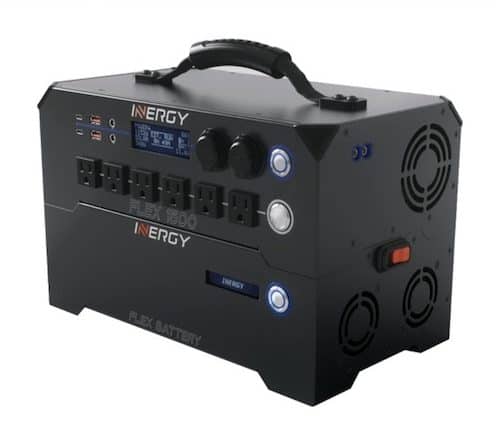
Another great solar generator matchup with the 3000X is the Inergy Flex. The Flex comes with a single 1,069Wh battery, but like the Titan solar generator, it has a modular design, allowing multiple batteries to attach to the bottom of the system.
Since the battery capacity for the Flex is a lot less than the 3000X, I am going to add two more batteries to the Flex, giving it a total of three batteries. In addition, Inergy has what they call the “MPPT Supercharger” that is optional with the Flex.
I will add this to the comparison. In the chart below, you’ll see that I have adjusted the numbers accordingly to account for the additional batteries and the MPPT Supercharger on the Flex.
Yeti 3000X vs Inergy Flex – Specs Comparison
From the chart above, you can see that the Inergy Flex is slightly more expensive than the 3000X with all of its additional equipment.
The Flex weighs slightly more and has a weaker AC inverter output, however, the Flex beats the 3000X in terms of battery capacity (about 200Wh more) and solar charging (600W more). The biggest difference here is the solar input.
If you value fast recharging, then the Flex may be a better option to have in your arsenal. In addition, if you want as much battery capacity as possible, you can attach up to 96 batteries to the Flex for a highly-capable power station setup.
However, the 3000X may be a better choice for other reasons that I’ll discuss below.
Another important factor to consider is battery lifecycles. The 3000X has 500 lifecycles to 80% capacity for its battery.
The Flex does not have an exact number of lifecycles for its battery, but Inergy claims that each battery “could last anywhere from 400 cycles up to 2,000 cycles or 10 years if you use it to run moderate loads and take good care of it.”
Let’s say that you take moderately good care of the Flex system and get 1,500 cycles out of it. That is still three times longer than the battery cycle life of the 3000X.
If you take out the MPPT Supercharger from the Flex, it will not have the 1,200W of solar input available, but it would cost less and be lighter as a result.
Check out the comparison below if we compare the 3000X to the Flex with an additional two batteries but without its MPPT Supercharger.
Specs Comparison – Yeti 3000X vs Flex (2x Additional Batteries)
This should give you a more accurate picture of each systems’ capabilities.
The 3000X beats the Flex in terms of:
- Solar input – 200W more
- Inverter power – 500W more (continuous and surge)
The Flex outranks the 3000X in its:
- Battery capacity – 173Wh more
- Weight – 16 lbs lighter than the 3000X with its roll cart; 7 lbs lighter without its roll cart
- Approximate battery lifecycles – if used with proper maintenance, anywhere from 500-1,000 additional cycles
There are several additional factors to consider when comparing these two models because the details will give you the absolute best option for you.
But before we get into them, the last point I want to make is regarding the replaceability of each battery.
Replacement Cost When Batteries Deplete
Say you buy the Inergy Flex with two additional batteries but only get 500 cycles out of them before reaching 80% capacity. Although this is on the low end of its lifecycle range, it’s still equal to the Yeti 3000X rating.
Now you will soon need three more batteries for your Flex, so you buy them at a cost of about $2,550 ($850/battery).
Since the Flex module separates from its batteries, you don’t have to replace it.
Similar: How Long Does a Solar Generator Last? (With Examples)
Now consider being in a similar predicament but you instead have the Yeti 3000X. The issue is that you cannot replace the battery inside of this power station, but instead you will need to get an entirely new system.
- Replacement cost for Yeti 3000X: $3,399.95
- Replacement cost for Inergy Flex (three batteries total): $2,550
- Difference: $850
When it comes to overall lifetime value, the Flex (with two additional batteries) wins in terms of replacement costs because you can replace its batteries without needing to replace the Flex power module.
Yeti 3000X vs Flex vs Titan Solar Generator – Down to Specifics
The 3000X, Flex, and Titan are all great feats of engineering, but what exactly makes them great besides their batteries, inverters, and solar input capabilities?
Now, we are going to focus on their ports and how the basic fundamentals of a solar generator translate into powering your devices, electronics, and appliances.
This comparison between the three power stations’ ports in addition to the previous information will give you a good idea of which one is most compatible with your specific needs.
The Inergy Flex comes in AC and DC versions, so we will be including both in this comparison.
Ports Comparison – Yeti 3000X vs Titan vs Flex AC vs Flex DC
The one feature of the Yeti 3000X that none of the other models have in this comparison is its regulated DC ports. All of the DC output ports are regulated, which means that the output voltage will remain constant from the Yeti’s DC ports to your devices.
How Do You Charge a Yeti 3000X?
There are four ways to charge a Yeti 3000X – From solar panels, a wall charger, a car charger, or via a USB-C charger. Wall charging and solar charging are the fastest charging methods. The Yeti 3000X comes with a 230W wall charger that connects to its High Power charging input.
You can also opt for the 600W AC charger if you want to recharge as fast as possible. The included 230W charger will recharge the Yeti 3000X in 14 hours, whereas the 600W charger will take only six hours to fully recharge the power station.
The 3000X does not come with a car charger, but it is available on Goal Zero’s website or on Amazon. This charging method as well as charging via the USB-C PD input will take over a day to recharge the power station from a completely depleted battery.
Solar Panel Options for the Yeti 3000X
The Boulder 200 Briefcase panel from Goal Zero can be used either individually or combined with multiple Boulder 200s to charge the Yeti 3000X.
Goal Zero sells a combiner cable that allows you to connect multiple Boulder panels into one side (up to four panels) and on the other end is a single High Power Port that connects into the 3000X’s input.
The largest solar panel offered by Goal Zero is the Ranger 300 Briefcase (affiliate link to Amazon).
This panel has four 75W panels that fold together when stored.
A more portable 200W panel than the Boulder 200 is the Nomad 200, which is half the weight of the Boulder model.
You can check out the similarities and differences between these two panels in my comparison post found here: Goal Zero Nomad 200 vs Boulder 200 (Complete Breakdown).
Yeti App – Included With the 3000X Among Other Yetis
One of the major aspects that sets the 3000X apart from other brands is the Yeti App. The solar generator models that this app supports are the 1400 Lithium, 3000 Lithium, 1000X, 1500X, 3000X, and 6000X.
The Yeti App allows you to turn on and off ports with a WiFi connection, measure your past usage with your generator, and toggle power metrics, all via your smartphone. The application also has a “Help” feature if you need assistance in understanding its features.
Check out the short video below from Goal Zero, where you’ll see the full suite of what the application has to offer.
How Do You Turn On a Yeti 3000X?
You turn on a Yeti 3000X by pressing one of its buttons on the front of the power station or by using the Yeti App via a paired smartphone/tablet to turn on its ports. Pressing any of the three output buttons on the Yeti 3000X (12V, USB, or AC) will turn its correlating ports section on or off.
Goal Zero’s X-Series Innovation Over Time
Overall, Goal Zero has given the public several variations of solar generators that will support people off the grid. Over the years they have improved their systems to constantly be the front runner in their industry.
By making a system such as the Yeti 3000X and the Yeti X series in general, Goal Zero has overcome their lead-acid batteries of the past, switched to MPPT charge controllers in their 500X model all the way to the 6000X, and have shown that they are making their systems better as a whole for the consumer.
Although the price of the Yeti X series is expensive, the 3000X is a solid example of a partial home-backup system when the power goes out among many other scenarios.
If you’re looking for more information, my detailed video analysis shows some more insights of the 3000X below.
If you’re looking for even more powerful solar generators, I recommend checking out my top three picks here: Top 3 Most Powerful Solar Generators (Overview + Analysis).




